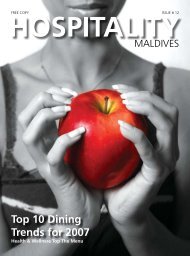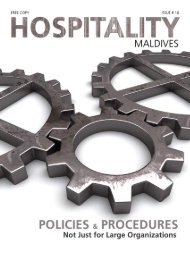Don't Let Your Systems Drive Your Customers Crazy! - Hospitality ...
Don't Let Your Systems Drive Your Customers Crazy! - Hospitality ...
Don't Let Your Systems Drive Your Customers Crazy! - Hospitality ...
You also want an ePaper? Increase the reach of your titles
YUMPU automatically turns print PDFs into web optimized ePapers that Google loves.
FOOD & BEVERAGE<br />
The Importance of Avoiding<br />
Cross-Contamination<br />
by Rich Kussin & Lynn Helmers,<br />
Procter & Gamble Foodservice<br />
Though invisible to the human eye, bacteria are omni-present<br />
in kitchens – both at home and in restaurants. They<br />
can affect food taste, but more importantly they can also<br />
impact the safety of the food we eat. Many bacteria live and can<br />
grow very rapidly in food particles, especially in moist foods with<br />
temperatures between 41 and 140 degrees Fahrenheit. Left untreated,<br />
they can cause salmonella or E coli food poisoning and<br />
other serious illnesses.<br />
The best defense against the dangers of bacteria is a clean<br />
kitchen. And while it’s extremely difficult to make cooking and<br />
food preparation surfaces and utensils fully bacteria-free, there<br />
are many steps foodservice professionals can and should take<br />
to both reduce the amount of bacteria present, and lower the<br />
likelihood of cross-contamination of bacteria between food ingredients<br />
and prepared dishes.<br />
First Line of Defense<br />
Hands are one of the major causes of cross-contamination. Bacteria<br />
that can cause illness are often present on hands, so it is<br />
important to wash hands frequently throughout the day. Washing<br />
hands before doing dishes helps to ensure that bacteria living<br />
on hands are not transferred into the dish water. And, washing<br />
hands after doing each task associated with food preparation<br />
helps to minimize the transfer of bacteria from raw to cooked<br />
foods, cold foods to hot and many more.<br />
Hot and Cold<br />
At the top of the list is making certain cooked foods and raw<br />
foods remain separated. This means using different cutting<br />
boards and utensils for cooked and uncooked foods during the<br />
preparation process, and making sure to wipe prep surfaces clean<br />
after every use.<br />
Cleaning Sink - Be certain the water in the cleaning sink is<br />
hot, ideally between 120 and 140 degrees Fahrenheit. Hot water<br />
helps to break up baked-on, caked-on food particles and to melt<br />
dried grease. This temperature is also necessary to activate the<br />
grease cutting and cleaning chemicals formulated into dish detergents.<br />
But chemicals added to the cleaning sink need to be strong<br />
enough to get the job done, too. Detergents such as the professional<br />
grade Dawn® Manual Pot and Pan Detergent include<br />
exclusive surfactant and solvent systems that work together to<br />
breakdown tough grease and clean more effectively. Dawn, for<br />
instance, delivers longer-lasting suds. And since suds are the signal<br />
of when it’s time to switch over the dish water in the cleaning<br />
sink, long-lasting suds mean less sink-turnover and more efficient<br />
dishwashing.<br />
In this step of dishwashing, a brush or cloth may be used to<br />
scrub food surfaces and completely remove all soils. However,<br />
the brush or cloth must be cleaned between uses to clear food<br />
particles that may become trapped in the bristles or fibers which<br />
can cross-contaminate the next batch<br />
of dishes.<br />
Proper Storage<br />
It is equally important to store foods properly, both in<br />
terms of temperature and containers. Foods that are<br />
meant to remain cold should be stored at temperatures<br />
under 41 degrees Fahrenheit. Foods meant to be hot<br />
should be held at temperatures above<br />
140 degrees Fahrenheit. And all foods must be stored in foodgrade<br />
packages, wrappings and containers.<br />
Cleansing and Sanitation<br />
The best method for cleansing and sanitization is a three-step<br />
process. In restaurants, this is completed in a three-compartment<br />
sink – in which one sink is dedicated to each step. And<br />
while some products claim to clean and sanitize all in<br />
one step, contentious food service pros continue<br />
to stress the importance of separately performing<br />
each step of the three-step process.<br />
‘‘ …all foods must be stored<br />
in food-grade packages,<br />
wrappings and containers. ”<br />
HOSPITALITY MALDIVES OCTOBER/NOVEMBER 2006

















